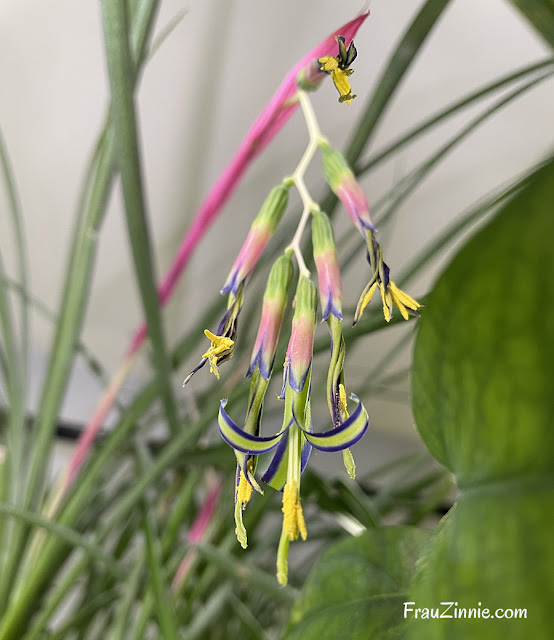These houseplants bring an exotic flair to indoor spaces, and are fairly low maintenance. The plants are epiphytes, meaning that the plant often uses another plant (such as a tree) as its host. The epiphytic plant is able to get all the nutrients it needs to survive from the air and rain. They do not hurt the host plant.
 |
| Billbergia nutans in flower. |
‘Queen’s Tears’ (Billbergia nutans) is in the bromeliad family, and the pink bracts remind me of flamingo feathers. Native to South America, it is an epiphytic plant that grows primarily on trees. It lives on the top shelf of one of my plant racks during the winter where it gets indirect light, and I let it spend the warmer season outside under the patio tent. I have had this plant in my collection for seven years - but I have not yet tried to divide it. It's low maintenance and blooms reliably every January.
 |
| Aeschynanthus acuminatus 'Black Pagoda' variety. |
'Lipstick Plant' (Aeschynanthus acuminatus) is another epiphyte that blooms in January for me. I have the 'Black Pagoda' variety, which produces an orange/yellow/green flower, but there are many kinds that feature a bright red flower instead. It does well with lower light, and can be potted up in hanging baskets to showcase its trailing tendencies.
 |
| Dendrobium nobile in bud form. |
This Dendrobium orchid (Dendrobium nobile) is just setting buds under the grow lights. This is a great orchid variety to try if you already have success growing the moth orchids (Phalaenopsis) and want to branch out to a new variety, but are not ready to try cattleyas yet. Similar to how I treat my moth orchids, I let this orchid summer outside under a shaded area, and leave it out for a couple of the first few nights that the temperatures begin to dip at night in the fall. This temperature fluctuation helps the plant to set flower buds.
Originally published Jan. 5, 2024. Updated on Jan. 1, 2026.

No comments
Post a Comment